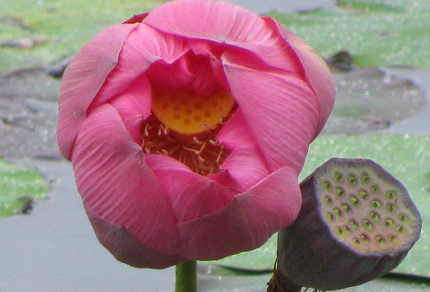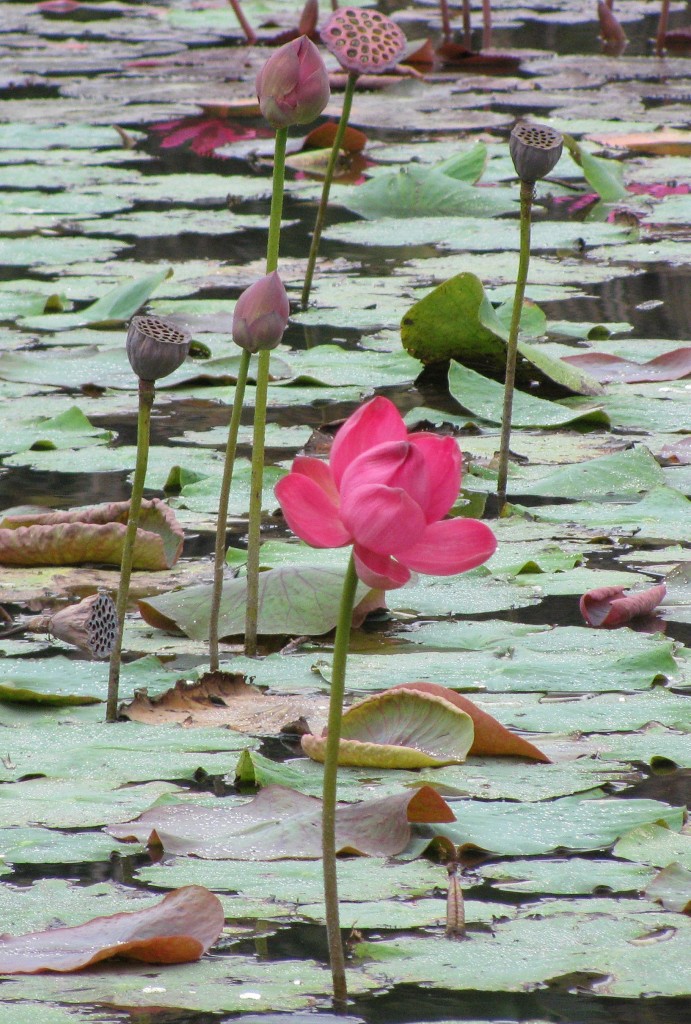
Lotus Lily Buds, Blossom, and Seed Heads (and curled leaves among water lily leaves) (© Magi Nams)
Early light swept sound and colour into Anderson Park Botanical Gardens, where insects rasped out rough songs in clumps of bamboo that stood like gigantic sheaves of grain, and where lotus lilies and pink water lilies graced a pond plied by fleets of paddling Pacific black ducks. The lotus lilies pushed up tall flowering stems, the buds atop them smooth, plump, and pointed, the blossoms featuring rounded petals and yellow centres, the seed heads resembling kettle drums having punctured tympani. Their circular leaves curled and warped amid the plates of indented waterlily leaves that lay more smoothly atop the pond.
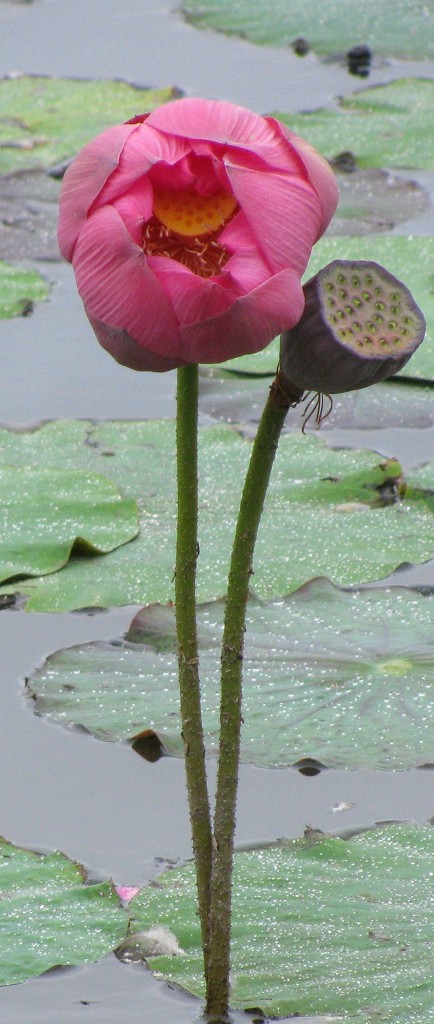
Lotus Lily (© Magi Nams)
The native Australian lotus, Nelumbo nucifera, is found in wetlands of Queensland and the Northern Territory, and is also native to eighteen other countries stretching from Iran to Japan and from far east Russia to Papua New Guinea.1 It’s revered by Asian cultures as a symbol of purity2 and is the national flower of Egypt, India, and Vietnam.3 I first observed lotus lilies in January, when I spotted massive pink blossoms on tall stems growing near shore in a quiet stretch of the Ross River above Aplin’s Weir. I was impressed with the sheer size of the flowers, and with their rich, pink beauty sprawling atop those upthrust stems. The lotuses of the Anderson Park gardens I saw this morning appeared much smaller, more circumspect in their loveliness.
On researching lotus lilies, I learned that these aquatic beauties are valued economically as bee plants and ornamentals, as well as sources of beads (seeds), folklore medicine, and food.1 Nearly all parts, including the flowers, young leaves, seeds, and rhizomes are edible, with cooked, sliced “roots” used in many Asian dishes and seeds eaten raw or like popcorn.2 It’s an interesting fact that lotus plants are able to maintain a flower temperature of 30-35°C even when the air temperature drops 20°C lower, a strategy Australian researchers Drs. Roger S. Seymour and Paul Schultze-Motel of the University of Adelaide suggested may attract sluggish, cold-blooded insect pollinators to the blossoms.2
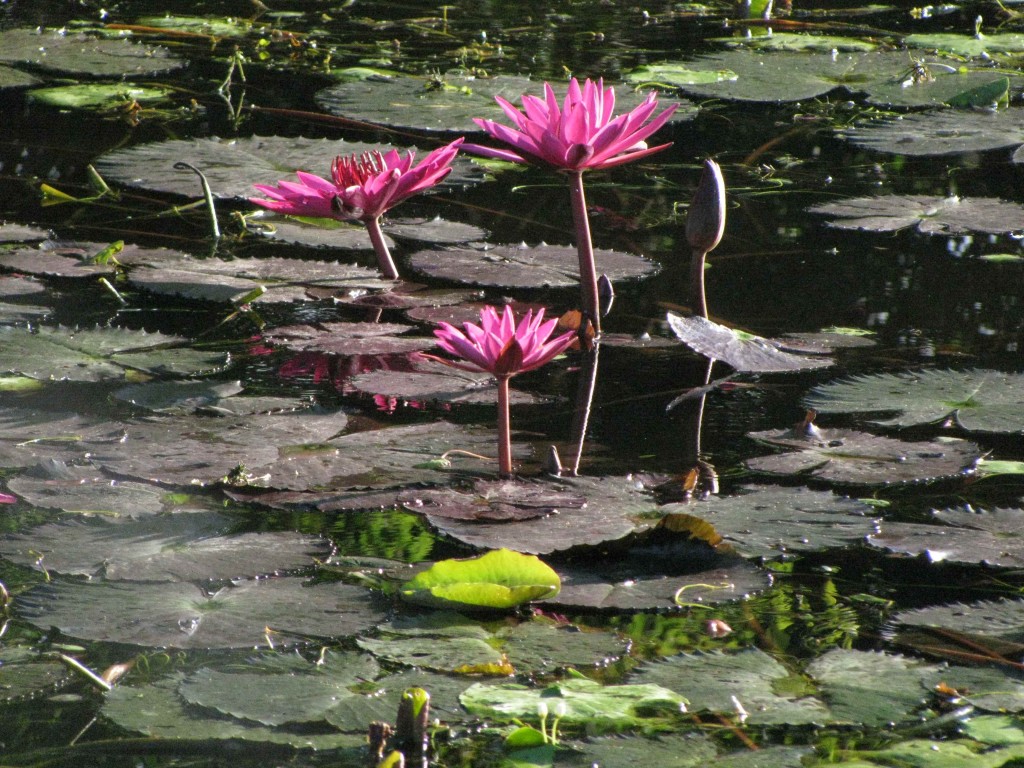
Water Lilies in Anderson Park Botanical Gardens (© Magi Nams)
Lotus lilies frequently cohabit with water lilies, which in the Anderson Park gardens lift stunning pink blossoms above the brown water on short stems. In addition to leaf shape and flower characteristics, lotus lilies and water lilies can be differentiated by the fact that the seed capsules of lotus lilies develop and remain atop lofty stems, while those of waterlilies sink beneath the water after flower petals are dropped. The survival of both forms of aquatic lily is threatened by the spread of highly invasive aquatic weeds, one of which is water hyacinth.4 This invader I have seen growing along the shoreline of the Ross River, where it forms thick, nearly impenetrable beds of floating, glossy green foliage and purple flowering spikes.
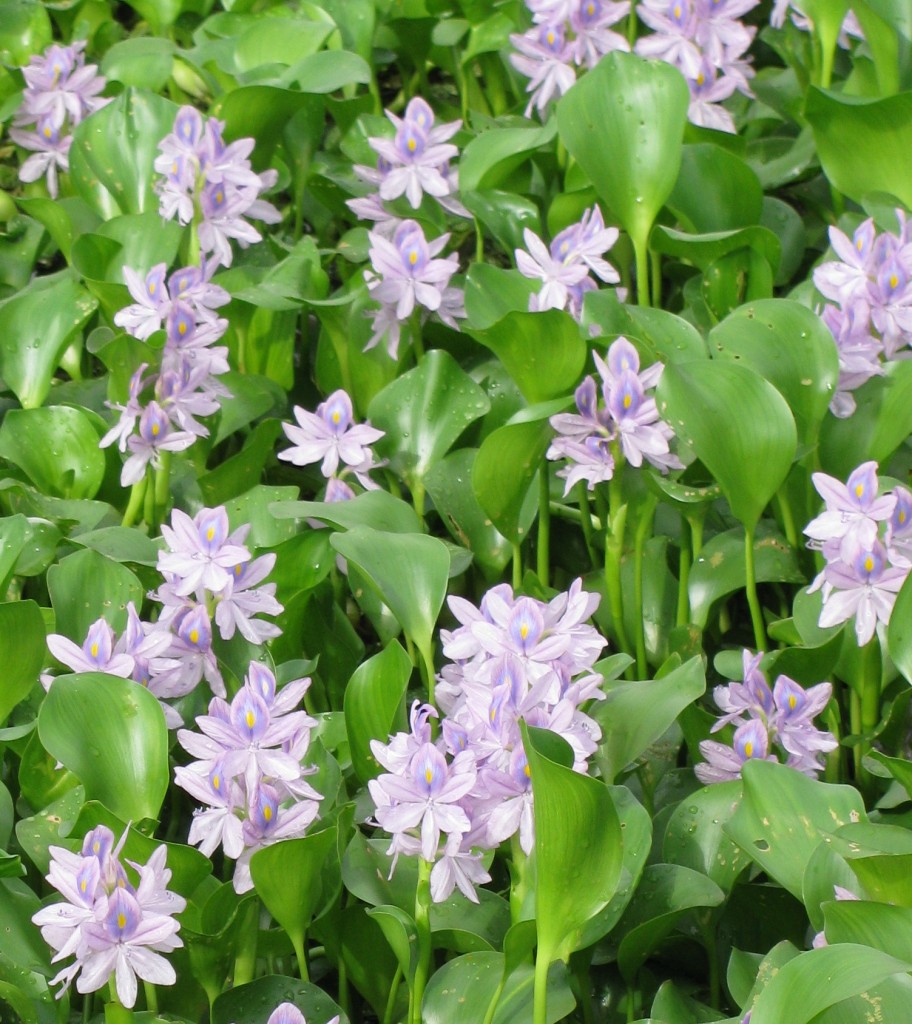
Water Hyacinth (© Magi Nams)
Australia is home to nine (possibly ten) species of native water lilies that occur in tropical and temperate wetlands of Queensland, Western Australia, and the Northern Territory. Nymphaea gigantea, with its blue, 30-centimetre blossoms, also occurs in New South Wales. Some of the native water lilies possess cup-shaped flowers, while others possess star-like flowers. Most have blue, white, or mauve blossoms, with some blending white with blue or purple. The flowers of one species open blue, but over a period of days transform to pink and then to red. Another species possessing small, white flowers blooms only at night5 In my travels, I have frequently encountered blue and white, or purple and white water lilies, and less commonly, pure white water lilies. To date, I have only observed the searing, hot pink variety (possibly a cultivar) at Anderson Park Botanical Gardens, where I have been drawn to its beauty again and again.
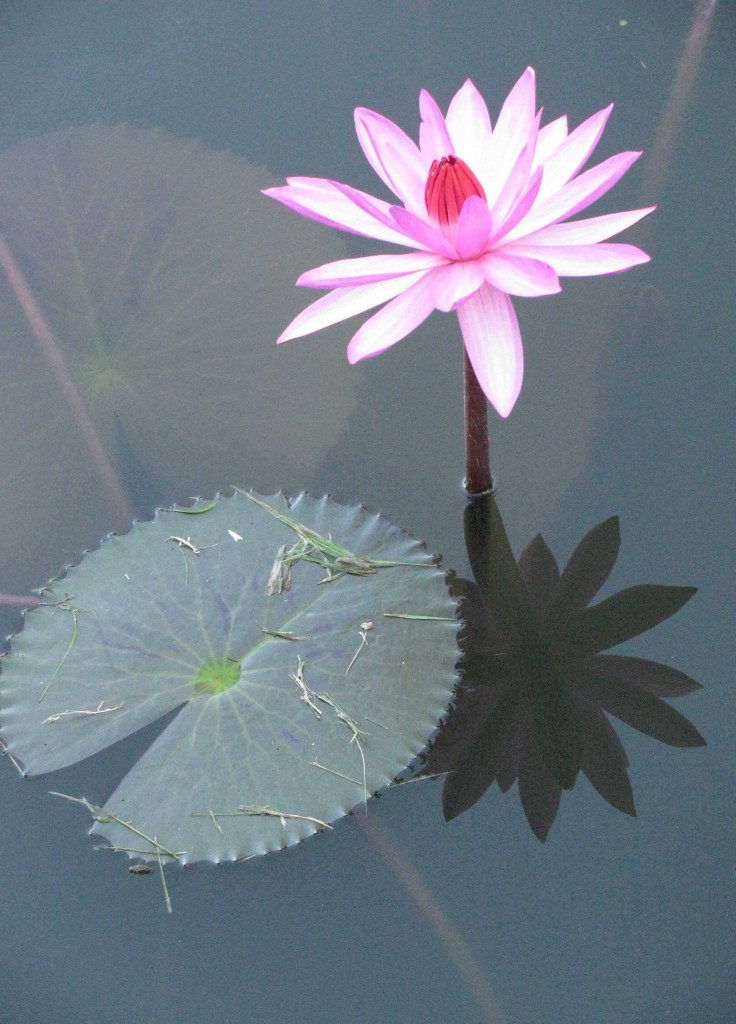
Water Lily in Anderson Park Botanical Gardens (© Magi Nams)
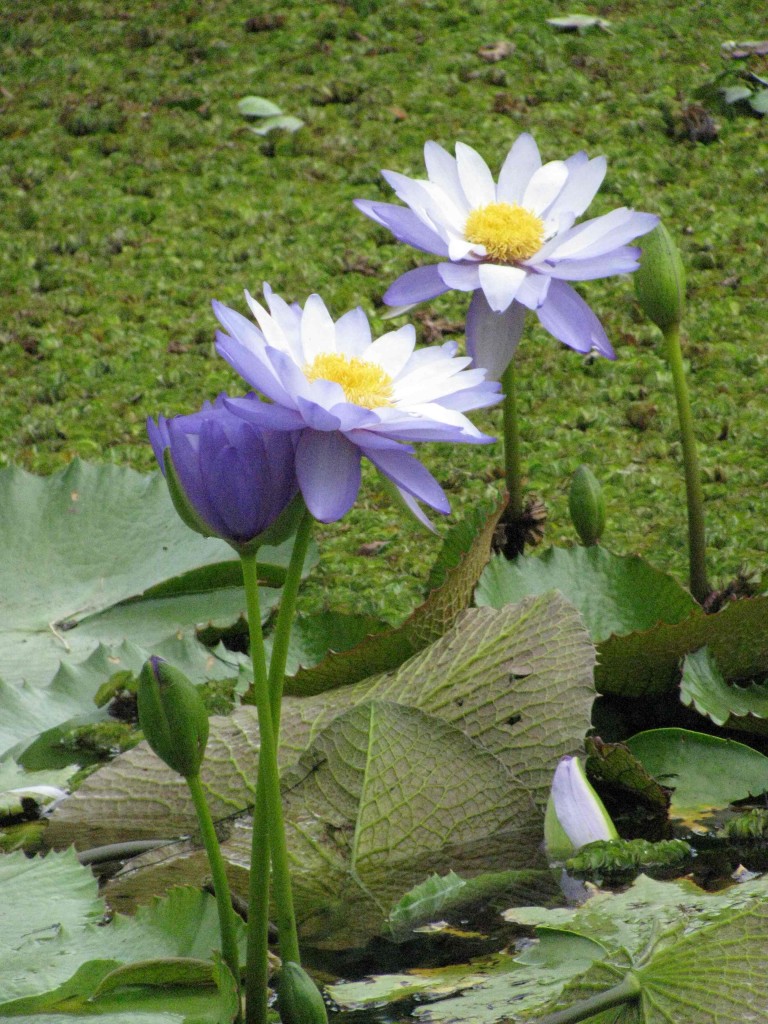
Water Lilies in Palmetum Park Wetland (Magi Nams)
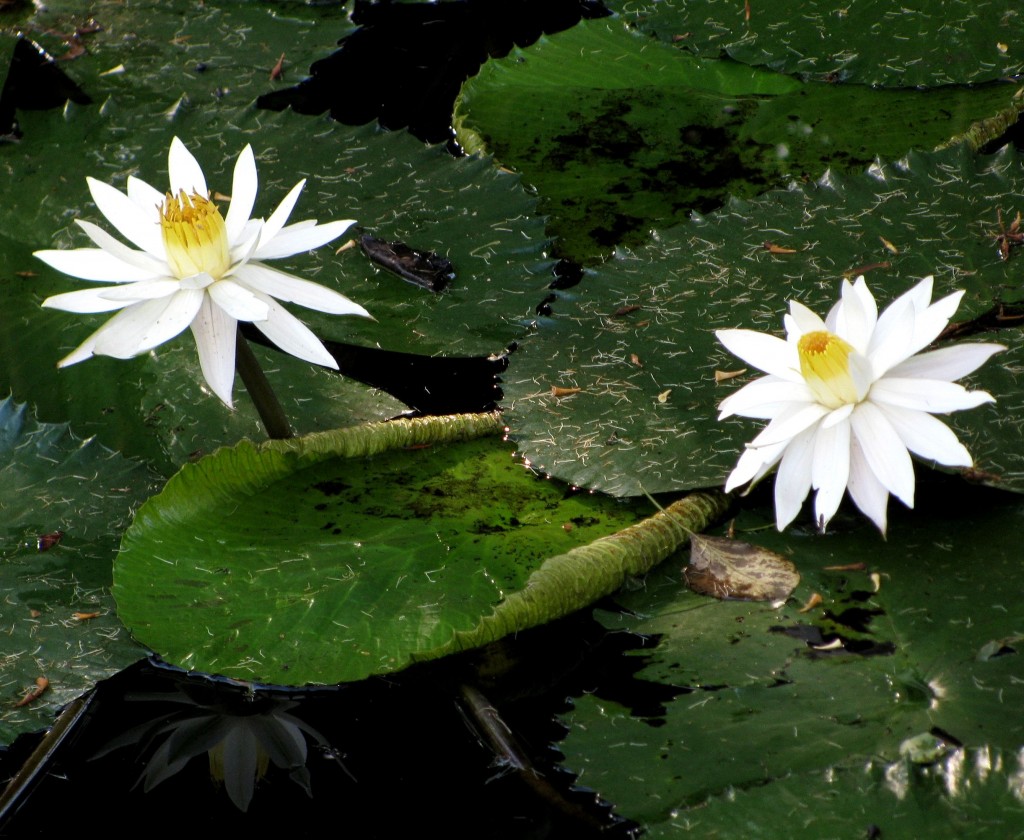
White Water Lilies growing in inlet off Ross River (© Magi Nams)
Today’s birds: rainbow lorikeets, white-gaped honeyeaters, blue-faced honeyeaters, Australian white ibis, yellow honeyeaters, great bowerbirds, mynas, white-breasted woodswallows, magpie-larks, Australian magpies, figbirds, peaceful doves, laughing kookaburras, Pacific black ducks, dusky moorhen, mallard, masked lapwings, white-bellied cuckoo-shrike, brown honeyeaters, helmeted friarbirds, black-faced cuckoo-shrikes, rainbow bee-eaters, brush cuckoo, rock doves, spangled drongo, collared sparrowhawk, olive-backed oriole, house sparrows, zebra finches, crested pigeons, yellow-throated miner. Also Cairns birdwing butterflies.
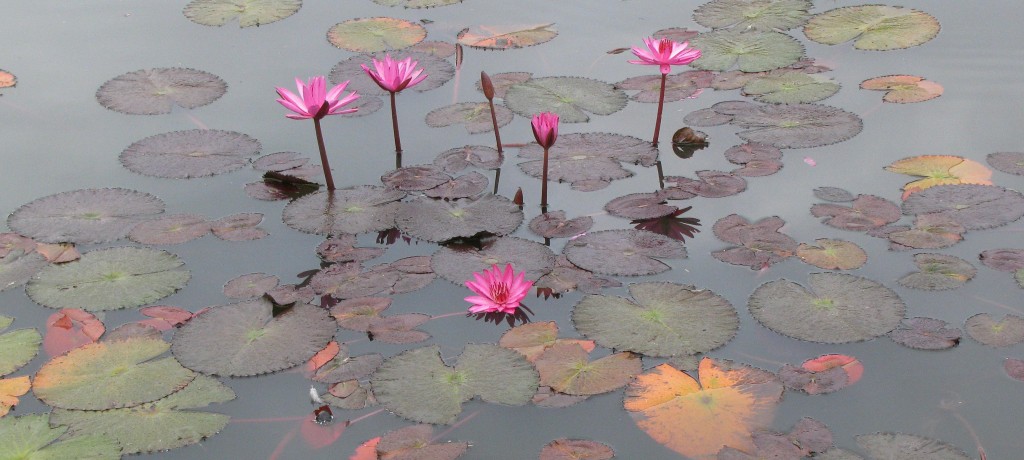
References:
1. USDA Agricultural Research Service, Germplasm Resources Information Network (GRIN); GRIN Taxonomy for Plants. Nelumbo nucifera Gaertn. Updated 31-Oct-2001. Accessed 23-Aug-2010. http://www.ars-grin.gov/cgi-bin/npgs/html/taxon.pl?25110
2. Wikipedia. Nelumbo nucifera. Updated 15-Aug-2010. Accessed 23-Aug-2010. http://en.wikipedia.org/wiki/Nelumbo_nucifera
3. Wikipedia. Nelumbo. Updated 22-Jul-2010. Accessed 23-Aug-2010. http://en.wikipedia.org/wiki/Nelumb
4. IHC Group Ltd., Australian Water Gardener. Australian Native Aquatics. © 2003-2010. Accessed 23-Aug-2010. http://au.water-gardener.com/content.asp?Category=359
5. IHC Group Ltd., Australian Water Gardener. Australian Native Waterlilies. © 2003-2010. Accessed 23-Aug-2010. http://au.water-gardener.com/content.asp?articleId=206; also Australian Native Waterlilies (2) http://au.water-gardener.com/content.asp?articleId=357

